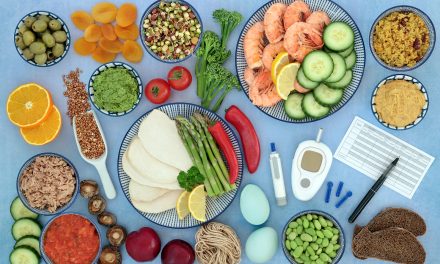Managing type 2 diabetes requires careful planning, especially when it comes to carbohydrate intake.
A balanced approach to diet can help maintain blood sugar levels and improve overall health.
For many people with type 2 diabetes, aiming for around 45-60 grams of carbohydrates per meal can be beneficial. This amount can vary depending on individual needs, activity level, and recommendations from healthcare professionals.

Carbohydrates play a significant role in affecting blood sugar. Understanding which foods contain carbohydrates and how they impact the body is crucial for effective meal planning.
Foods rich in fiber can help slow down the absorption of sugar, aiding in better blood sugar control.
Those managing their condition should focus on complex carbohydrates, which provide sustained energy and fewer spikes in blood sugar levels.
Incorporating strategies for blood sugar control and tailoring meal plans can enhance health outcomes.
Reading food labels to understand carbohydrate content can empower people to make informed choices.
Consulting with healthcare professionals ensures that the dietary plan aligns with individual health goals and consideration of other factors.
Key Takeaways
- Optimal carb intake for type 2 diabetes is 45-60 grams per meal.
- Fiber-rich foods aid in blood sugar control.
- Personalized meal plans and professional guidance are essential.
Understanding Carbohydrates and Diabetes

Carbohydrates play a crucial role in managing diabetes. They directly affect blood sugar levels, with various types offering different impacts.
Knowing the difference between simple and complex carbs helps in planning meals that keep blood sugar stable.
Types of Carbohydrates
Carbohydrates come in three main types: sugars, starches, and fiber.
Sugars, like glucose and fructose, are simple carbs found in fruits and sweets. They quickly raise blood sugar.
Starches, or complex carbs, are in foods like grains and starchy vegetables. They take longer to digest, providing a steady release of sugar. Examples include potatoes, corn, and rice.
Fiber is important for digestion and regulating blood sugar. It’s found in whole grains, legumes, and vegetables. Unlike other carbs, it doesn’t raise blood sugar.
Eating more fibrous foods helps slow sugar absorption, which benefits blood sugar regulation.
The Role of Carbs in Blood Sugar Regulation
Carbs are the main source of energy, but they also impact blood sugar.
When consumed, carbs break down into glucose, entering the bloodstream. This can spike blood sugar levels.
To manage this, it’s important to balance total carbohydrates and net carbs.
Foods with a low glycemic index, such as legumes and whole grains, are better choices. They cause a slower, smaller rise in blood sugar.
Choosing complex carbohydrates over simple ones aids in maintaining balanced blood sugar levels. Meal planning with an emphasis on fiber and whole grains helps achieve better control and stability.
Carbohydrate Needs in Type 2 Diabetes

Managing carbohydrate intake is vital for people with type 2 diabetes. It impacts blood sugar levels and overall health.
Understanding how to determine and adjust carb intake can improve the management of the condition.
Determining Your Carb Intake
Daily carbs should be spread evenly across meals to help maintain stable blood sugar levels.
A personalized approach works best, as needs vary based on factors like age, activity level, and individual health goals.
The American Diabetes Association often suggests a range of 45-60 grams of carbs per meal as a starting point.
Consulting with a registered dietitian or diabetes educator can help in setting a personalized carb goal. They provide guidance in carb counting, ensuring that carbohydrates are managed properly to avoid spikes in blood glucose and maintain a balanced A1c level.
Factors Influencing Carb Needs
Carb needs can change due to several factors, impacting how much one should consume.
Physical activity increases energy expenditure, potentially requiring more carbs to sustain energy levels.
Health conditions, such as obesity or insulin resistance, may call for greater restriction or more careful monitoring.
It’s important to consider any medications, as they can affect carbohydrate metabolism.
Consulting a healthcare professional, like a nutritionist or a diabetes educator, helps in understanding these factors.
Regular monitoring of blood sugar levels provides insights into how well the diet meets the body’s demands, allowing for necessary adjustments.
Creating a Nutritious Meal Plan

For people with type 2 diabetes, creating a meal plan involves balancing carbohydrates, proteins, and other nutrients while keeping total calories in check. This helps manage blood sugar levels effectively and promotes good health.
Balancing Nutrients in Meals
To balance nutrients in meals, start by understanding carb counting. This helps in monitoring the number of carbohydrates consumed per meal.
It’s recommended that meals focus on complex carbohydrates like whole grains and avoid processed sugars. Portion sizes should be controlled to maintain a healthy diet.
Protein is essential and should be included in every meal to help with weight loss and stabilize blood sugar.
Choose lean options like chicken, fish, or plant-based proteins.
Incorporating fiber from fruits, vegetables, and whole grains is important. It helps reduce blood sugar spikes.
Examining nutritional labels allows for better tracking of total carbs and calories. Following dietary guidelines ensures that meals provide all essential nutrients while managing diabetes.
Examples of Balanced Meals for Type 2 Diabetics
Creating balanced meals can be simple by including a variety of food groups.
For breakfast, consider a bowl of oatmeal topped with berries and a side of Greek yogurt. This combines healthy carbs, fiber, and protein.
For lunch, a grilled chicken salad with mixed greens, quinoa, and avocado provides nutrients like fiber and healthy fats. Use a light vinaigrette as dressing to keep calories in check.
Dinner can include baked salmon, a serving of brown rice, and steamed broccoli. This meal balances carbs, protein, and fiber effectively.
Snacks like a small apple with a tablespoon of almond butter can be included. This ensures nutrient balance without exceeding portion sizes. These meal examples provide a pathway to follow dietary guidelines and maintain health.
The Impact of Fiber on Diabetes Management

Dietary fiber plays a significant role in the management of type 2 diabetes. It helps regulate blood sugar levels and can contribute to overall heart health by influencing blood cholesterol levels. Understanding the different sources of dietary fiber and their specific benefits is crucial for those managing diabetes.
Sources of Dietary Fiber
Dietary fiber is found in various plant-based foods. Whole-grain products like brown rice and whole wheat bread are excellent sources. Additionally, legumes such as beans and lentils offer a high fiber content.
Nonstarchy vegetables, including broccoli and leafy greens, provide fiber without a high carbohydrate load.
It is important to check nutrition labels to identify foods high in fiber and low in added sugars. The daily intake recommendation for fiber is typically about 25-30 grams for most adults.
Fiber’s Role in Blood Sugar Regulation
Fiber is crucial in regulating blood sugar by slowing the absorption of carbohydrates, leading to more stable blood sugar levels.
Soluble fiber, found in foods like oats and fruits, is particularly beneficial. This type of fiber forms a gel-like substance in the gut.
This process not only aids in blood sugar control but may also improve blood cholesterol, contributing to heart health.
Including fiber-rich foods in meals can help manage diabetes effectively by providing stable energy release and reducing glucose spikes.
Strategies for Controlling Blood Sugar Through Diet
Controlling blood sugar effectively involves understanding the right diet strategies. This includes using the glycemic index to make food choices and adopting low-carb diet approaches. These strategies can aid in managing diabetes and improve overall health.
Understanding the Glycemic Index
The glycemic index (GI) ranks foods by how much they raise blood sugar. Eating low-GI foods helps keep blood sugar levels stable.
Non-starchy vegetables like broccoli and spinach, beans, and certain fruits are examples of low-GI options.
Including these in meals can benefit those managing diabetes.
Instead of consuming high-GI foods like white bread, opting for whole grains is recommended. Understanding GI also aids in the timing of mealtime insulin for those using an insulin pump, providing an additional tool for better blood sugar control.
Low-Carb Diet Approaches
A low-carb diet, including the ketogenic diet, restricts carbohydrate intake to maintain stable blood glucose.
By reducing carb servings in everyday meals, individuals can experience better blood sugar management. Meals often include lean proteins, healthy fats, and non-starchy vegetables.
Such an approach not only aids in controlling diabetes but also helps in weight management.
Diabetes self-management education (DSME) encourages people to adopt these eating habits along with other lifestyle changes.
This approach can be vital for achieving long-term health goals for those with type 2 diabetes. For more details on a low-carb diet’s effects, see the study on appetite and glucose control.
Reading and Understanding Food Labels
People with type 2 diabetes must pay close attention to carbohydrate intake. Reading nutrition labels effectively can help manage blood sugar levels by making informed food choices. Understanding how to interpret and calculate carbohydrate content is crucial.
Interpreting Carb Information on Labels
Nutrition labels provide essential details about food contents.
Carbohydrates are typically listed as total carbohydrates, which include fiber, sugars, and starches. It’s important to note the serving size since all values are based on this amount. For items like cereals or dairy products, serving sizes can vary greatly.
Labels also list sugars, providing insight into how much of the total carbohydrates come from sugar.
When managing diabetes, seeking foods with lower sugar content can help control blood glucose levels. Check for added sugars, which may be listed separately.
For more specific advice, individuals often look for foods with more dietary fiber, as it can reduce the impact on blood sugar.
Those reading labels should also be aware of claims like “low-carb” or “no sugar added” and verify these by checking the actual carbohydrate content.
Calculating Net Carbs
Calculating net carbs helps determine how much carbohydrate affects blood sugar.
To calculate net carbs, subtract the fiber and sugar alcohols (if listed) from the total carbohydrates on the label.
Net carbs focus on carbs absorbed by the body.
For example, if a serving size has 20 grams of total carbs, 5 grams of fiber, and 2 grams of sugar alcohol, the net carbs would be 13 grams. This formula helps tailor carb intake to one’s dietary needs.
Using net carbs can be especially helpful when consuming foods that naturally contain fiber like cereals or certain dairy products. People with type 2 diabetes can make smarter dietary choices by understanding net carbs, which in turn aids in managing their condition effectively.
Lifestyle and Dietary Adjustments for Long-term Health
For individuals managing type 2 diabetes, making changes to lifestyle and diet plays a key role in maintaining long-term health. Routine physical activity and attention to stress levels and sleep quality can help in managing weight, controlling blood sugar, and improving overall well-being.
Incorporating Physical Activity
Engaging in regular physical activity is beneficial for people with 2 diabetes. It helps improve blood sugar levels, aids in weight loss and enhances mood.
Activities such as walking, cycling, or swimming are ideal.
Incorporating strength training exercises can increase muscle mass, which helps the body use insulin more effectively.
Aim for 150 minutes of moderate activity each week, broken into manageable sessions. For those starting out, even small amounts of movement can make a difference.
Over time, gradually building up to more intense activities is recommended for better results. Consistency is key to reaping the maximum benefits from exercise.
Stress Management and Sleep
Managing stress levels and ensuring adequate sleep are critical for maintaining health in individuals with diabetes.
High stress can lead to elevated blood sugar levels, while lack of sleep affects insulin sensitivity.
Stress reduction techniques such as meditation, deep breathing, or yoga can be helpful.
Prioritizing sleep hygiene is vital. This includes maintaining a regular sleep schedule, creating a restful environment, and avoiding caffeine or screens before bedtime.
Getting 7 to 9 hours of quality sleep per night helps in balancing hormones and improving blood sugar control.
Establishing these habits can significantly improve one’s ability to manage diabetes effectively while also supporting heart health and lowering cholesterol and blood pressure.
Consulting with Healthcare Professionals
Working with healthcare professionals can be crucial for managing type 2 diabetes. They provide tailored advice on diet and lifestyle changes, helping individuals understand and control their carbohydrate intake.
Finding the Right Support Network
Forming the right support network involves consulting with various specialists like dietitians, nutritionists, and diabetes educators. These professionals offer individualized guidance on crafting a balanced diet.
A dietitian can help create meals that account for carbohydrate intake while still being nutritious. Organizations such as the American Diabetes Association provide resources to locate qualified professionals.
Getting advice from a nutritionist or diabetes educator ensures that ongoing dietary management aligns with health goals. Engaging with a comprehensive support network can ease the stress of managing diabetes.
Diabetes Self-Management Education and Support
Education and support are vital in managing type 2 diabetes effectively. Programs often involve group or one-on-one sessions led by certified diabetes educators.
They help individuals understand carbohydrate counting and meal planning. This knowledge empowers patients to make informed dietary choices.
Institutions like the Mayo Clinic offer resources for diabetes self-management education. Attending these sessions can enhance understanding of diabetes management, including the role of exercise and medication.
With proper guidance, patients can better track their progress and adjust their approaches as needed.
Frequently Asked Questions
Individuals with type 2 diabetes should carefully manage their carbohydrate intake to maintain healthy blood sugar levels. This involves understanding how many carbs to consume daily, making healthy food choices, and knowing the effects of carbs on the body.
What is the daily carbohydrate intake recommendation for individuals with type 2 diabetes?
For people with type 2 diabetes, daily carbohydrate intake often ranges between 45-60% of total daily calories. The exact amount can vary based on personal health goals, activity levels, and dietary needs.
It’s important to consult with a healthcare professional for personalized advice.
How can a type 2 diabetic determine the optimal number of carbs to consume per meal?
To determine optimal carbs per meal, individuals should monitor blood sugar responses and consult a dietitian. Decision trees and tools can help guide portion sizes.
Typically, meals may contain 45-60 grams of carbs, but personal variations exist.
What are considered healthy carbohydrate choices for people with type 2 diabetes?
Healthy carb choices include whole grains, legumes, fruits, and vegetables. These foods have fiber and nutrients that help manage blood sugar levels.
It’s best to avoid refined sugars and processed foods that can quickly spike blood sugar.
How does carbohydrate intake affect blood sugar levels in individuals with diabetes?
Carbohydrate intake directly affects blood sugar. Simple carbs are quickly converted to glucose, causing spikes in blood sugar levels.
In contrast, complex carbs are digested slowly, leading to a gradual increase in blood sugar, which is easier to manage.
What are the guidelines for carbohydrate consumption for women with type 2 diabetes?
Women with type 2 diabetes are often advised to aim for 30-45 grams of carbohydrates per meal. This can vary based on individual health goals and lifestyle.
Working with a healthcare provider can help tailor recommendations to personal needs.
Can limiting carbohydrates excessively impact the health of a person with type 2 diabetes?
Excessive carb restriction can lead to nutritional deficiencies and low energy, which might negatively affect overall health.
It is essential to maintain a balanced diet that includes adequate nutrients while managing carbs to support health and prevent complications.
















